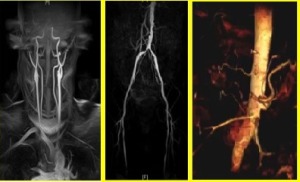by
Lauren Dubinsky, Senior Reporter | September 30, 2016
The standard for imaging blood vessels requires a contrast agent that can cause more damage to the kidneys of patients with diabetes or renal failure. Radiologists at the Cook County Health & Hospital System (CCHHS) are looking into whether non-contrast MR angiography (MRA) is a better alternative.
“Patients with kidney disease are at higher risk for man-made debilitating disease called Nephrogenic Systemic Sclerosis from use of Gadolinium based contrast agents,” Dr. Dheeraj Reddy Gopireddy, diagnostic MR and imaging program director at CCHHS, told HCB News. “Advanced non-contrast MRA techniques currently provide us with safe and effective alternative ways to study vascular imaging in renal insufficiency patients.”
MRA is a noninvasive imaging test that uses MR to evaluate blood vessels and help spot arterial disease and abnormalities. Non-contrast techniques are less expensive and require less time than a standard MR with contrast.



Ad Statistics
Times Displayed: 120958
Times Visited: 6963 MIT labs, experts in Multi-Vendor component level repair of: MRI Coils, RF amplifiers, Gradient Amplifiers Contrast Media Injectors. System repairs, sub-assembly repairs, component level repairs, refurbish/calibrate. info@mitlabsusa.com/+1 (305) 470-8013
“Not only do these techniques answer the clinical question but also give us the option to repeat the imaging without injecting contrast,” said Gopireddy.
Other options for assessing vascular diseases are CT angiogram and ultrasound. However, CT radiation can be harmful and ultrasound doesn’t always provide clear images, especially if the patient is obese.
One of the downsides of non-contrast MRA is that it requires a high training curve and should only be performed at hospitals with extensive technical skills. The MR team at John H. Stroger Jr. Hospital has mastered the techniques because of the high prevalence of diabetes and kidney disease in their patient population.
“As newer and safer MRA techniques evolve there will be a training curve for the technicians and radiologists,” said Gopireddy. “We do not foresee any strong reasons not to adopt these techniques, other than unavailability of the software on the MR scanners.”

